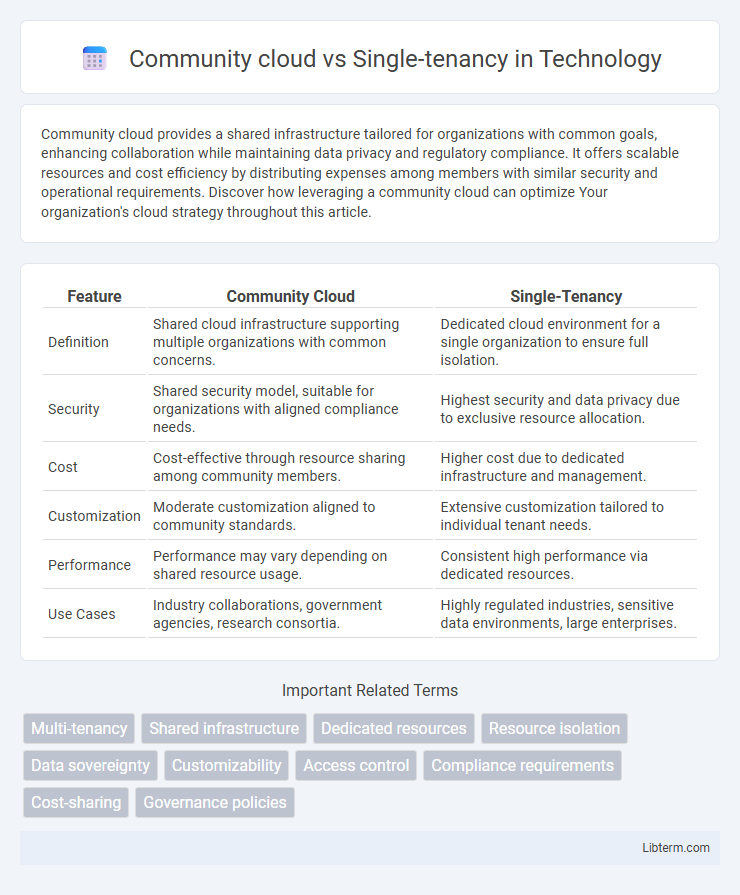Community cloud provides a shared infrastructure tailored for organizations with common goals, enhancing collaboration while maintaining data privacy and regulatory compliance. It offers scalable resources and cost efficiency by distributing expenses among members with similar security and operational requirements. Discover how leveraging a community cloud can optimize Your organization's cloud strategy throughout this article.
Table of Comparison
| Feature | Community Cloud | Single-Tenancy |
|---|---|---|
| Definition | Shared cloud infrastructure supporting multiple organizations with common concerns. | Dedicated cloud environment for a single organization to ensure full isolation. |
| Security | Shared security model, suitable for organizations with aligned compliance needs. | Highest security and data privacy due to exclusive resource allocation. |
| Cost | Cost-effective through resource sharing among community members. | Higher cost due to dedicated infrastructure and management. |
| Customization | Moderate customization aligned to community standards. | Extensive customization tailored to individual tenant needs. |
| Performance | Performance may vary depending on shared resource usage. | Consistent high performance via dedicated resources. |
| Use Cases | Industry collaborations, government agencies, research consortia. | Highly regulated industries, sensitive data environments, large enterprises. |
Introduction to Community Cloud and Single-Tenancy
Community cloud offers a shared infrastructure designed specifically for organizations with common interests, enabling collaboration while maintaining data privacy among tenants. Single-tenancy provides dedicated resources to a single organization, ensuring complete control and customization of the environment without resource sharing. Both models address different needs in cloud computing concerning security, cost-efficiency, and operational control.
Key Concepts and Definitions
Community cloud is a collaborative cloud computing environment where infrastructure is shared among multiple organizations with common concerns such as security, compliance, or jurisdiction, enabling cost efficiency and resource optimization. Single-tenancy refers to a cloud architecture where a single customer has exclusive access to the entire cloud infrastructure, ensuring higher levels of customization, security, and control. The key difference lies in resource sharing: community cloud distributes resources across multiple tenants with shared objectives, while single-tenancy isolates resources for one tenant only.
Architecture Overview: Community Cloud vs Single-Tenancy
Community cloud architecture enables multiple organizations to share infrastructure and resources within a secure, multi-tenant environment tailored for collaborative use cases, offering cost efficiency and centralized governance. Single-tenancy architecture dedicates physical or virtual resources exclusively to one organization, ensuring isolated data environments and customized configurations for enhanced security and compliance. The architecture differences impact scalability, resource allocation, and maintenance, with community clouds emphasizing shared access and single-tenancy focusing on individualized control.
Security and Data Privacy Considerations
Community cloud environments offer enhanced security and data privacy by enabling multiple organizations with shared concerns to govern access controls and compliance policies collectively, reducing risks associated with multi-tenant data exposure. Single-tenancy provides exclusive infrastructure allocation, minimizing vulnerability to data breaches through isolated resources and customized security protocols tailored to a single organization's requirements. Both models require rigorous encryption, identity management, and regulatory adherence, but single-tenancy typically delivers stronger data isolation, whereas community cloud emphasizes collaborative security governance among trusted parties.
Cost Implications and Budgeting
Community cloud offers shared infrastructure costs among multiple organizations, resulting in lower upfront capital expenses and predictable operating budgets compared to single-tenancy. Single-tenancy requires dedicated resources, leading to higher costs for hardware, maintenance, and specialized IT staff, which can strain budgeting for smaller businesses. Evaluating cost implications involves assessing long-term scalability, resource utilization, and the total cost of ownership unique to each deployment model.
Scalability and Flexibility Comparison
Community cloud provides higher scalability and flexibility by sharing resources among multiple organizations with similar needs, allowing dynamic allocation of computing power and storage based on demand. Single-tenancy offers dedicated resources to one organization, resulting in more predictable performance but limited ability to scale rapidly or adapt to fluctuating workloads. Therefore, community cloud environments are better suited for organizations requiring scalable and flexible infrastructure, while single-tenant models offer isolation and control at the expense of elasticity.
Compliance and Regulatory Requirements
Community cloud environments allow multiple organizations with similar compliance and regulatory requirements to share infrastructure while maintaining data segregation, enhancing adherence to industry standards like HIPAA, GDPR, and FedRAMP. Single-tenancy provides dedicated resources to one organization, ensuring full control over data security and compliance processes, which is crucial for highly regulated industries requiring strict isolation and auditability. Organizations must evaluate their specific compliance mandates and risk tolerance when choosing between the shared governance model of community clouds and the exclusive environment of single-tenant setups.
Use Cases and Industry Applications
Community cloud suits industries with shared regulatory requirements like healthcare, finance, and government by enabling multiple organizations to collaborate securely while maintaining compliance. Single-tenancy is ideal for enterprises needing stringent data isolation, customized environments, and full control, such as in banking, legal firms, and large-scale SaaS providers. Use cases for community cloud include joint research projects and multi-organization resource sharing, whereas single-tenancy supports mission-critical applications demanding high security and performance.
Challenges and Limitations
Community cloud faces challenges in maintaining data privacy and security due to shared infrastructure among multiple organizations, which can lead to compliance complexities and potential data breaches. Single-tenancy offers improved security and customization, but it incurs higher costs and limited scalability, restricting resource sharing and efficient utilization. Both models struggle with balancing cost-effectiveness, performance, and regulatory compliance, impacting deployment choices for businesses with specific needs.
Choosing the Right Model for Your Organization
Community cloud offers shared infrastructure tailored to organizations with common goals, enhancing collaboration and cost-efficiency. Single-tenancy provides dedicated resources guaranteeing maximum security, customization, and performance for individual enterprises. Choosing the right model depends on your organization's priorities in data privacy, compliance requirements, scalability, and budget constraints.
Community cloud Infographic

 libterm.com
libterm.com